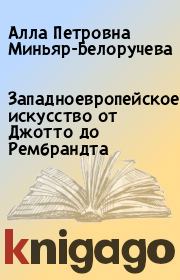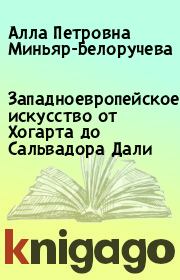Алла Петровна Миньяр-Белоручева - Западноевропейское искусство от Джотто до Рембрандта
пособие для изучающих английский язык | Название: | Западноевропейское искусство от Джотто до Рембрандта |
Автор: | Алла Петровна Миньяр-Белоручева | |
Жанр: | Языкознание, Изобразительное искусство, фотография | |
Изадано в серии: | неизвестно | |
Издательство: | неизвестно | |
Год издания: | - | |
ISBN: | неизвестно | |
Отзывы: | Комментировать | |
Рейтинг: | ||
Поделись книгой с друзьями! Помощь сайту: донат на оплату сервера | ||
Краткое содержание книги "Западноевропейское искусство от Джотто до Рембрандта"
Учебный центр
«Московский Лицей»
пособие для изучающих английский язык
издание второе переработанное и дополненное
Москва -1999
Рецензенты:
И. И. Малинина кандидат филологических наук
Н. В. Васютина кандидат филологических наук
РЕКОМЕНДОВАНО кафедрой иностранных языков исторического факультета МГУ им. М. В. Ломоносова
Тексты настоящего пособия охватывают пять веков западноевропейской живописи от Джотто до Рембрандта. Это дает возможность обучаемым приобрести не только лингвистические знания, усвоив обширный лексический материал, но и культурологические, поскольку последовательный хронологический переход текстов от одного художника к другому позволяет создать более или менее целостную картину развития западноевропейской искусства с XIII по XVII вв. Система упражнений направлена на усвоение лексического материала и развитие навыков устной речи.
Данная книга является первой частью цикла учебных пособий для изучающих английский язык и предназначена для студентов-искусствоведов, учащихся классических гимназий, лицеистов и всех интересующихся искусством.
© Миньяр-Белоручева А. П.
© Оформление «Московский Лицей», 1999
ISBN 5-7611-0181-5
Издательство «Московский Лицей» Адрес: Москва, Ярославское ш., д.2, корп. 1
Телефон: (095) 188-59-71
Факс: (095) 188-33-10
Печ. л. 8,0. Тираж 5000 экз.
Читаем онлайн "Западноевропейское искусство от Джотто до Рембрандта". [Страница - 3]
- 1
- 2
- 3
- 4
- 5
- . . .
- последняя (34) »
VI. Arrange the following in the pairs of antonyms:
a) to accept; to accomplish; to rule out; three-dimensional; to produce; to recall; to decline;
b) flat; to revive; to forget; to include; to reject; to start; to break.
IV. Here are descriptions of some of Giotto's works of art. Match them up to the given titles.
1. The angels and saints firmly stand on either side of the throne.
2. The man wrapped in graveclothes is read together with the rock.
3. Humiliated, his head bowed, he stands between two shepherds.
4. The persons grieve in the manner possible to their individual personalities.
a. Lamentation
b. Raising of Lazarus
c. Joachim among the Shepherds
d. Madonna and Child Enthroned
V. Translate the text into English.
Конец XIII – начало Xiv вв. в европейской живописи знаменуется переходом от условных традиций средневековья к реалистическим традициям эпохи Возрождения и связан с именем Джотто, который впервые ввел свет и внутреннее пространство. Композиции Джотто просты. В Капелле дель Арена в Падуе цикл фресок из 38 сцен на тему «Искупление Грехов», главными героями которых являются Христос и Мария, Джотто расположил в три ряда. Сюжеты из Евангелия художник представил как реальные события. Вместо условного золотого фона византийских мозаик Джотто ввел пейзажный фон. Он добился трехмерного пространства определенным расположением (arrangement) фигур на плоскости стены. В отличие от византийских фигур, висящих в пространстве, герои Джотто твердо стоят на ногах.
VI. Summarize the text.
VII. Topics for discussion.
1. Giotto's style and characters.
2. Giotto as the father of modern painting.
Unit II Masaccio (1401-1427/29)
The break between what had gone before and the new 15th century creative art of Florence is seen immediately in the Enthroned Madonna and Child by the short-lived Tommaso di Ser Giovanni known to his contemporaries as Masaccio who was, after Giotto, the next great founder-figure not only of Italian but of Western painting. This picture is a central panel of an altar-piece painted by Masaccio when he was twenty-five. Its revolutionary heroic realism can be paralleled only in the work of his friend, the sculptor Donatello, older than Masaccio but working in Florence at the same time. In spite of the Gothic pointed arches used for the panels and the golden background this is a Renaissance picture. Masaccio's Madonna and Child are a simple, sculpted group, as if blocked out from the same piece of stone, absorbed, archaic and unsmiling images. The throne on which they sit and on which the large monumental Madonna casts a shadow is solid and three-dimensional. The Child is realistically human and seriously divine. He takes grapes from his Mother as a solemn foretaste of the Passion.Masaccio's innovations are visible in the frescoes he painted about 1425 in the Chapel of the Brancacci family in Florence. In his mid-twenties he revolutionised the art of painting. In the principle scene in the series the Tribute Money Masaccio created a new sense of actual masses existing in actual space. The subject recounts how when Christ and the Apostles arrived at Capernaum, the Roman tax-gatherer came to collect tribute. Christ told Peter he would find the tribute money in the mouth of a fish in the nearby Sea of Galilee. Peter cast for the fish, found the coin, and paid the tax-gatherer. The artist has arranged the Apostle figures in a semicircle around Christ, with the discovery of the money placed in the middle distance at the left and the payoff at the right. The Apostles are enveloped in cloaks. This gives them the grandeur of sculpture and a sense of existence in space. The Apostles' faces are painted with quick, soft strokes of the brush. Masaccio has performed a miracle almost without the use of line. Form is achieved by the impact of light on an object. In this picture Masaccio proved a simple maxim that 'Nothing is seen without light'. Unlike Giotto who had attempted to take the observer only a few yards back into the picture, where he immediately encountered the flat, blue wall, Masaccio leads the eye into the distance, over the shore of Galilee, past half-dead trees to the range of far-off mountains, and eventually to the sky with its floating clouds. And while Giotto'sought for the best means of telling the story selected as the subject, Masaccio sought a fitting incident which as a theme, would enable him to depict the characters he chose to represent.
On the narrow entrance wall to the chapel Masaccio painted his vision of the Expulsion from Eden. In this fresco the clothed angel floats above, sword in one hand, the other hand points into a desolate and treeless world. Adam's powerful body is shaking with sobs; he covers his face with his hands in a paroxysm of guilt and grief. Eve covers her nakedness with her hands, but lifts up her face in a scream of pain. Masaccio's drawing of the human figures and faces is masterly. Never before the nude figures had been painted with such breadth and ease; and the man's separation from God had never before been represented with such tragic intensity.
Masaccio made a great advance in both linear and aerial perspective; his figures were placed firmly on different planes in the same composition. Masaccio's style was characterised by his contemporaries as «pure, without ornament». By the fifteenth century the Brancacci Chapel had become the place where young artists including Michelangelo, went to learn from Masaccio – the basic principles of form, space, light, and shade of the Renaissance painting.
Make sure you know how to pronounce the following words:
Masaccio; Renaissance; Donatello; Florence; Apostles; Galilee; Capernaum; Milan; Eden; archaic; paroxysm
Notes
Tribute Money – «Чудо со статиром»(«Подать»)Expvlsionfrom Eden – «Изгнание из Рая»
Enthroned Madonna and Child – «Мадонна с Младенцем на Престоле»
the Passion – Страсти Господни
Tasks
I. Read the text. Mark the following statements true or false.1. Masaccio was the first founder-figure of Italian painting.
2. 'Nothing is seen without light' was Giotto's maxim.
3. Masaccio created a new sense of supernatural reality.
4. Late life Masaccio revolutionised the art of painting.
5. In a paroxysm of guilt and grief Eve covers her face.
6. The Arena Chapel became the place where young artists studied the basic principles of the Renaissance painting.
II. How well have you read? Can you answer the following questions?
1. What did Masaccio paint at the age of twenty-five?
2. How did Masaccio develop Giotto's innovations? What miracle did Masaccio perform?
3. Is the Enthroned Madonna and Child a Gothic or Renaissance picture? Why?
4. What does the subject of the Tribute Money recount? How did Masaccio group the figures?
5. What differs the Masaccio from the Giotto? How far did Masaccio take the observer into his painting the Tribute Money?
6. What is represented in --">- 1
- 2
- 3
- 4
- 5
- . . .
- последняя (34) »
Книги схожие с «Западноевропейское искусство от Джотто до Рембрандта» по жанру, серии, автору или названию:
 |
| Алла Петровна Миньяр-Белоручева - Западноевропейское искусство от Джотто до Рембрандта Жанр: Языкознание Год издания: 1999 |
 |
| Владимир Иванович Даль, Анатолий Николаевич Филиппов - 1000 русских пословиц и поговорок Жанр: Языкознание |
 |
| Коллектив авторов - Основы русской деловой речи Жанр: Языкознание Год издания: 2015 |
 |
| Умберто Эко - Сказать почти то же самое. Опыты о переводе Жанр: Языкознание Год издания: 2015 |
Другие книги автора «Алла Миньяр-Белоручева»:
 |
| Алла Петровна Миньяр-Белоручева - Западноевропейское искусство от Джотто до Рембрандта Жанр: Языкознание |
 |
| Алла Петровна Миньяр-Белоручева - Западноевропейское искусство от Хогарта до Сальвадора Дали Жанр: Языкознание |



